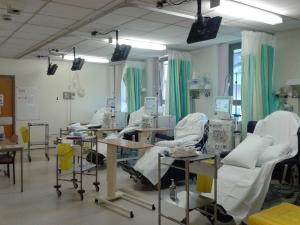- Group home
- You must register/login in order to post into this group.
Lighting Project

By: Bradford Teaching Hospitals NHS Foundation Trust
Additional benefits include an improvement in measured lighting levels and reduced maintenance costs as the new light fittings have a longer life span. An informal post-evaluation survey has shown that staff are happier with the increased levels of lighting. Apart from an improved working environment the project contributes to the achievement of the Trust's sustainable development goals and a redution in its climate change levy.
£612 per year (Estimated)
2.3 tonnes CO2e per year (Estimated)
The renal service decided to invest the full value of a BJRM Innovation in Renal Medicine Award 2011 prize (£5,000) in a greener healthcare energy saving initiative. Following a site survey of the renal unit, the lighting project was chosen as the most appealing in terms of delivery, risk and savings. The survey revealed that the fluorescent light fittings were of a 'T8' type, whose energy consumption can be up to two times that of a modern 'T5' light fitting. Existing luminaires had started to degrade and could not produce all the expected light from the fluorescent tubes. Following a consultation exercise with renal unit staff, a plan was agreed to install 'T5' light fittings. A total of 85 light fittings were changed in the Renal unit offices and wards.
The project was part of an on-going collaboration between the local Green Nephrology Champion and the Trust Estates department. The feasibility study, survey and business case were carried out by Mr Nsipa Siwale (Energy Manager). Activities included risk assessments, product selection, tendering and project management. Departmental support and funding was provided by Dr John Stoves. To minimise risks and disruption to staff and patients, most of the work was carried out after normal working hours.
Benefits to environmental sustainability
The annual operating hours for lighting in the Renal unit are 3,000 hours. The average energy saving per individual light is 36 kilowatt hours per year. Based on a greenhouse gas conversion factor of 0.58982 kgCO2e/kWh*, the project will save 11.5 tonnes of CO2e over 5 years.
* “All-scopes grid rolling average” emissions factor for electricity consumed (2010), Table 3c, Defra 2012 greenhouse gas conversion factors for company reporting
The main aim of the project was to reduce carbon emissions. The consultation exercise also revealed the need to improve levels of illumination in the unit, for example in the rooms used by technical staff.
The contractor for the project was JA Richardson Ltd, an experienced contractor who has undertaken several jobs successfully at the Trust with an excellent knowledge of the Trust and good Health and safety track record in the execution of similar projects.
A solar panel installation project may contribute to a further reduction in future charges.
